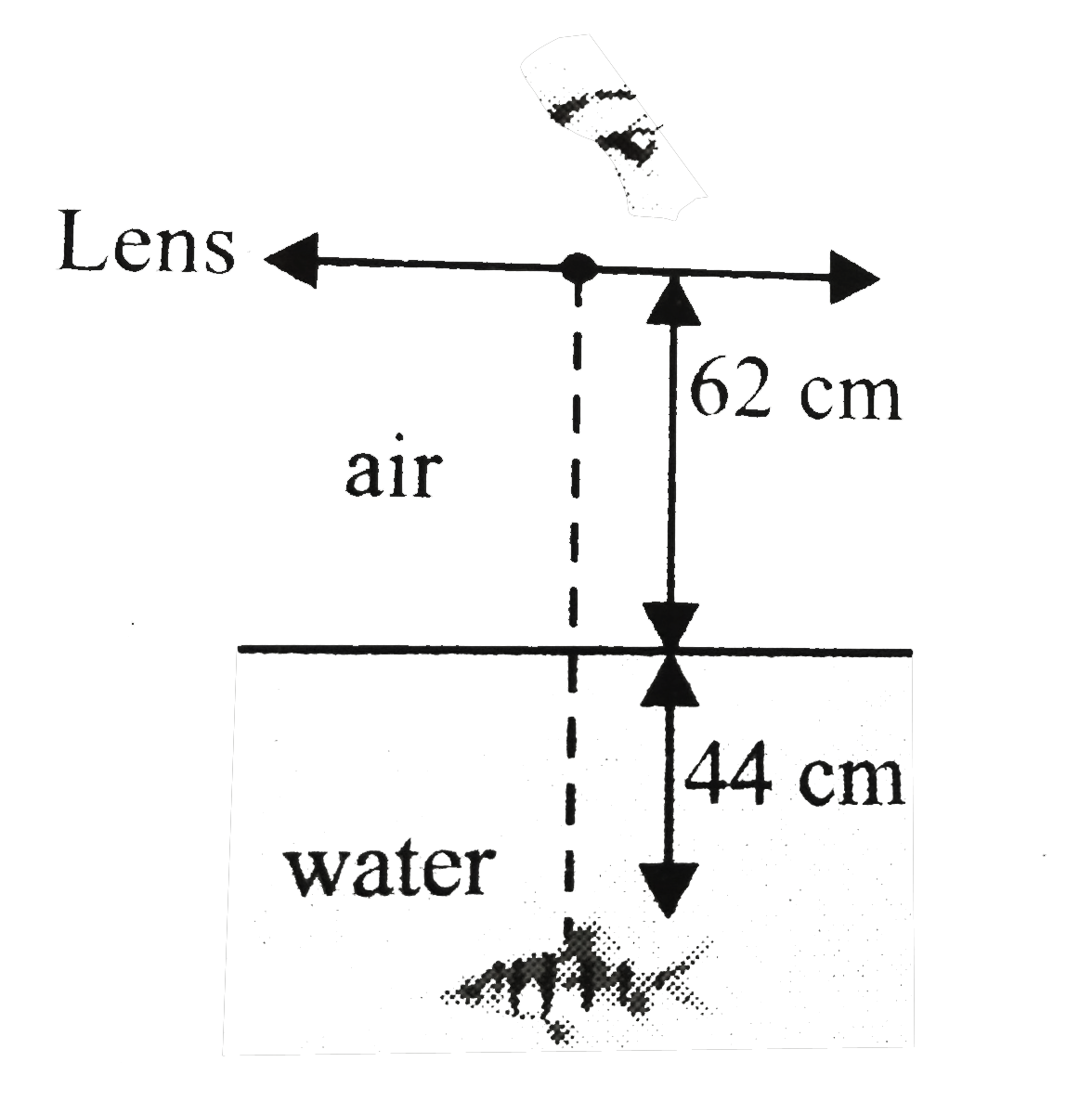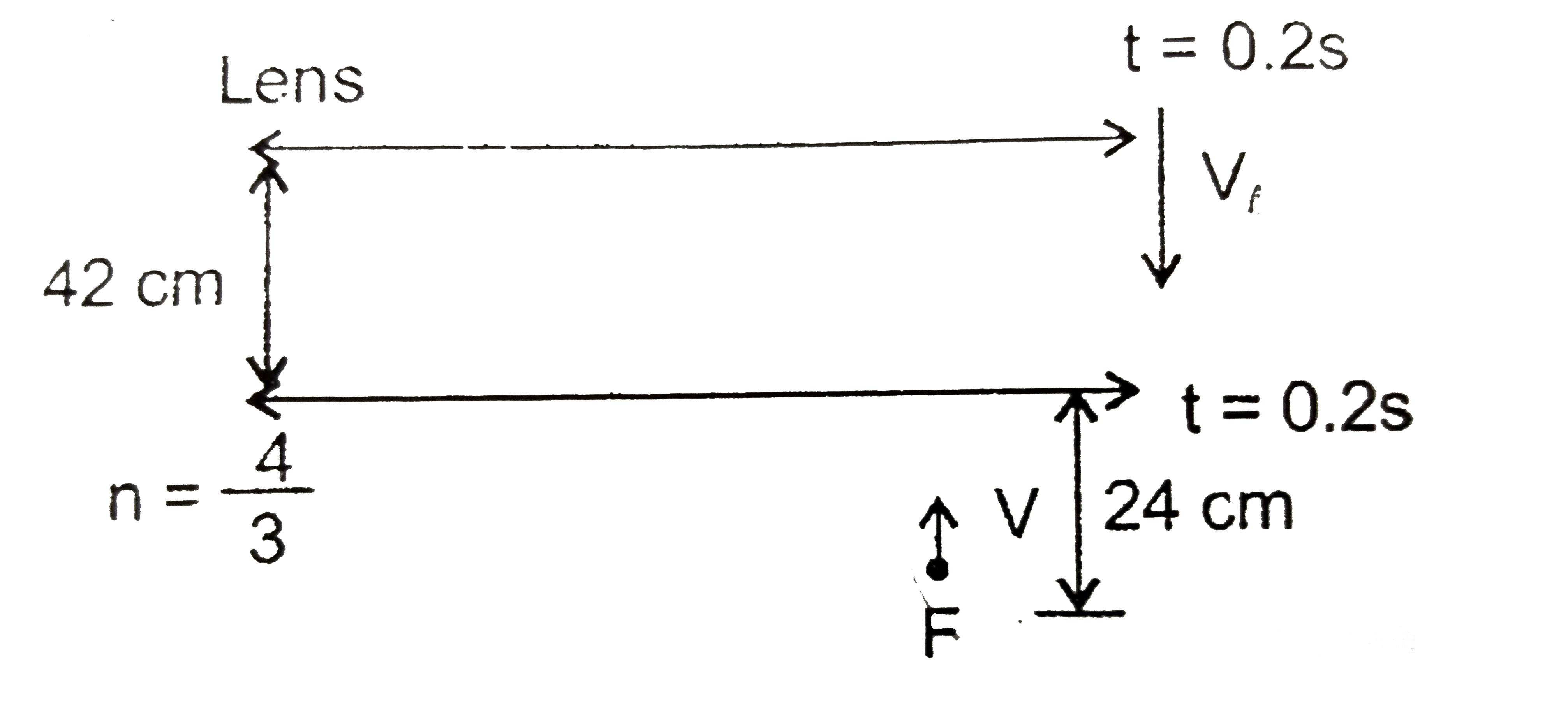A stationary observer O looking at a fish F in water (μw=4/3) through a converging lens of focal length 90.0cm . The lens is allowed to fall frelly from a height 62.0cm with its axis vertical. The fish and the observer are on the principal axis of the lens. The fish moves up with constant velocity 100cm/s. Initially it was at depth of 44.0cm . Find the velocity (in cm//s) with which the fish appears to move with respect to lens to the observer at t=0.2s. (take g=10m/s2)

The correct Answer is:22
At t=0.2sec , velocity of lens
Vl=≥2m/s (downwards)
∴ For lens the fish appears to approach with a speed of 2+(1×34)=114m/s
at a distance of ⎛⎜
⎜⎝42+24(43)⎞⎟
⎟⎠=60cm

∴ distance of image from lens, V=−60×90−60+90=−180cm .
∴ Velocity of image w.r.t . lens Vi=(v2u2)dudt=(−180−60)2×114=994m/s
velocity of image w.r.t. observer =Vi−2=994−2914m/s=22.75m/s (upwards)
Topper's Solved these Questions
- BOOK - RESONANCECHAPTER - GEOMATRICAL OPTICS EXERCISE - Exercise-379videos
GEOMATRICAL OPTICS
- BOOK - RESONANCECHAPTER - GEOMATRICAL OPTICS EXERCISE - Advance level Problems35videos
GEOMATRICAL OPTICS
- BOOK - RESONANCECHAPTER - GEOMATRICAL OPTICS EXERCISE - Exercise-1142videos
GEOMATRICAL OPTICS
- BOOK - RESONANCECHAPTER - EXPERIMENTAL PHYSICSEXERCISE - PART -II10videos
EXPERIMENTAL PHYSICS
- BOOK - RESONANCECHAPTER - GRAVITATIONEXERCISE - HIGH LEVEL PROBLEMS16videos
GRAVITATION
Similar Questions
Knowledge Check
- Question 1 - Select One
An object 5cm in length is held 25cm away from a converging lens of focal length 10cm. Then the position and height of the image is
A50/3 cm , 3.33 cmB-50/3 cm , -3.33 cmC50/3 cm , -3.33 cmD-50/3 cm , 3.33 cm - Question 2 - Select One
An object O is kept infront of a converging lens of focal length 30 cm behind which there is a plane mirror at 15 cm from the lens.
_E01_080_Q01.png) AThe final image is formed at 60 cm from the lens towards right of itBThe final image is at 60 cm from lens towards left of itCThe final image is realDThe final image is virtual
AThe final image is formed at 60 cm from the lens towards right of itBThe final image is at 60 cm from lens towards left of itCThe final image is realDThe final image is virtual - Question 3 - Select One
A convex lens of focal length 10cm and concave lens of focal length 20cm are kept 5cm apart. The focal length of the equivalent lens is
A1203cmB18cmC30cmD403
A diverging lens of focal length 20 cm and a converging lens of focal length 30 cm are placed 15 cm apart with their principal axes coinciding. Where should an object be placed on the principal axis so that its image formed at infinity ?
View SolutionA convex lens of focal length 20 cm is placed in contact with a concave lens of focal length 12.5 cm in such a way that they have the same principal axis. Find the power of the combination .
View SolutionA small fish 0.4 m below the surface of a lake is viewed through a simple converging lens of focal length 3 m.the lens is kep at 0.2 m above the water surface such that the fish lies on the optical axis of the lens. Find the image of the fish seen by the observed. (μwater=43)
View SolutionA small fish, 0.4m below the surface of a lake, is viewed through a simple converging lens of focal length 3m. The lens in kept at 0.2m above the water surface such that the fish lies on the optical axis of the lens. Find the image of the fish seen by the observer. The refractive index of water is 4/3.
View SolutionA convex lens of focal length 10.0 cm is placed in contact with a convex lens of 15.0 cm focal length. What is the focal length of the combination ?
View Solution

